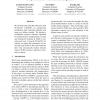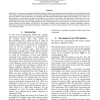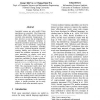281 search results - page 21 / 57 » Similarity-based Word Sense Disambiguation |
109
click to vote
EMNLP
2007
15 years 1 months ago
2007
We develop latent Dirichlet allocation with WORDNET (LDAWN), an unsupervised probabilistic topic model that includes word sense as a hidden variable. We develop a probabilistic po...
LREC
2010
15 years 1 months ago
2010
In this article, we present an experiment of linguistic parameter tuning in the representation of the semantic space of polysemous words. We evaluate quantitatively the influence ...
COLING
2008
15 years 1 months ago
2008
Annotated corpora are only useful if their annotations are consistent. Most large-scale annotation efforts take special measures to reconcile inter-annotator disagreement. To date...
ECAI
2000
Springer
15 years 4 months ago
2000
Springer
Abstract. This paper describes an experimental comparison between two standard supervised learning methods, namely Naive Bayes and Exemplar–basedclassification, on the Word Sens...
PAMI
2010
14 years 11 months ago
2010
— Word sense disambiguation (WSD), the task of identifying the intended meanings (senses) of words in context, has been a long-standing research objective for natural language pr...



